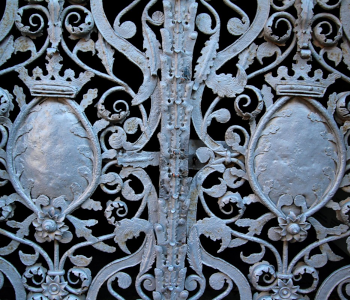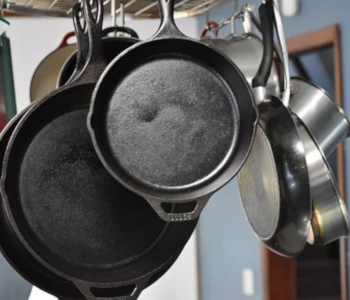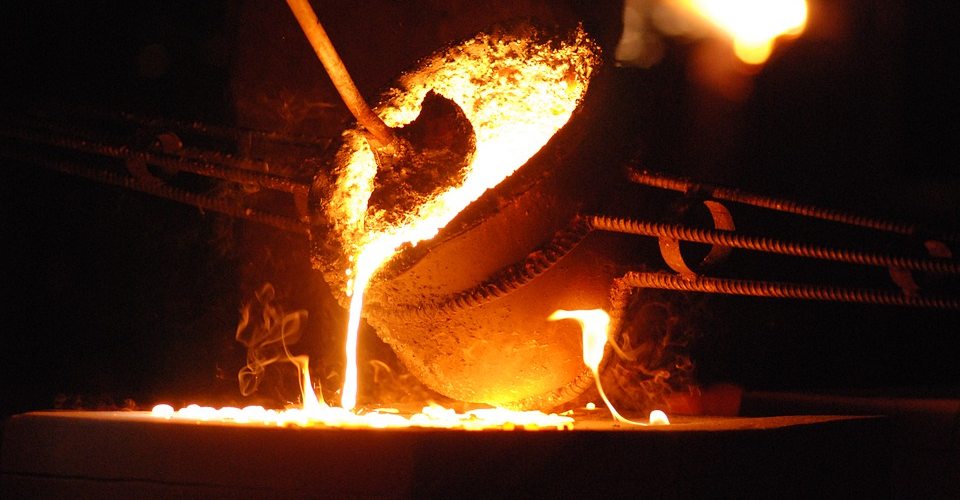Wrought Iron vs. Cast Iron: What They Are and Their Pros and Cons
Not only is iron one of the most reliable engineering materials in all of human history, but it’s also widely because of how abundant it is naturally. Raw iron can be processed and refined in a huge number of ways to produce the various grades of steels and alloys that can be found practically everywhere – from the smallest smartphones to the largest skyscrapers.
For this article, we are focusing on two specific iron products: wrought iron and cast iron. The different methods by which these iron products are made give them unique physical advantages that are suitable for particular applications. Let’s take a dive into what sets wrought iron and cast iron apart, and why they have become historically relevant materials.
What is wrought iron?

The term “wrought iron” is used a lot nowadays, often incorrectly, to refer to historical metal pieces, regardless of the actual metal composition. When any custom-shaped metal piece that has been painted black is referred to as wrought iron, this is an inaccurate statement that fails to take into consideration the technical definition of what wrought iron is. However, there were undoubtedly actual wrought iron pieces that were created throughout history, given that wrought iron was discovered as early as 2000 BC.
Based on composition, wrought iron is made of more than 99% iron by mass and a very low amount of carbon. Up to 2% by weight of cast iron is made of inclusions made of slag, a metal separation by-product typically composed of metal oxides, metal sulfides, and silicon dioxide. During processing, the slag fibers become fibers that give wrought iron a unique finish and texture. The silica content of the slag also helps give wrought iron some corrosion protection and resistance to impact and vibration.
Wrought iron derives its name from the process by which it’s made. Raw iron is literally “wrought” – an archaic version of the term “worked” – while still molten hot by hammering and folding. Because of how malleable and ductile low-carbon iron is when heated, this process can be done multiple times to work the iron into specific shapes. The more heating cycles a piece of wrought iron undergoes, the stronger it becomes.
If you’ve ever seen a medieval movie where a blacksmith hammers a piece of iron to produce weapons, then you have a good idea of how wrought iron is made. A medieval setting is also appropriate for wrought iron, as the process has now mostly gone out of fashion in favor of cheaper and more physical desirable alternatives, such as mild steel. Products that used to be made using wrought iron, such as garden fences and gates, are now often made using a casting process.
Pros and cons of wrought iron
From the mere fact that the practice of making real wrought iron is no longer as widespread as it used to be, it’s obvious that its disadvantages far outweigh its strengths in today’s modern industrial age. However, it would be remiss to forget the benefits that have made wrought iron popular in the first place.
PROS
1. Stronger and more ductile than cast iron
The low carbon content of wrought iron gives it a bit of extra ductility, allowing it to deform to a greater degree before failing. This characteristic has made wrought iron the material of choice for many of its old-fashioned applications such as in bridges, railroad tracks, and the boilers used in steam-powered boats. Wrought iron is highly resistant to fatigue, making it excellent for equipment that are subjected to a lot of stress.
2. Holds coatings well
Wrought iron naturally has a rough exterior surface, which makes it suitable for holding platings and coatings. Compared to cast iron or steel, a wrought iron surface can hold coatings that are up to 40% thicker. This is great for protecting wrought iron pieces against corrosion and other deleterious effects of weather. Because of the excellent adherence of coating treatment to wrought iron, it was often used for outdoor applications like gates, guardrails, and fences.
CONS
1. Very labor-intensive manufacturing process
The main reason why virtually no one makes wrought iron anymore is the fact that it takes a lot of manual work to get even a single wrought iron piece done. Between the repeated cycles of heating, hammering, folding, and cooling, it can take several days to weeks to finish a piece made of wrought iron. Not only is this costly, but it also means that the slow throughput can no longer keep up with the fast-paced demands of modern consumers.
Modern manufacturing methods, such as casting or lathing, are simply more economical for large companies. For this reason, even objects that are traditionally made using wrought iron have been shifted towards steel and other alternatives. Outside of historical sites and recreations of historical tools and weapons, you would be hard-pressed to find real wrought iron nowadays.
Applications of wrought iron
There are very few present-day applications of wrought iron because of how impractically tedious and time-consuming the process of making it is. Historically, though, wrought iron was one of the most widely used materials in engineering. The workability of wrought iron made it an excellent material for decorative pieces and accents such as rails, grilles, balconies, fences, and gates. Some of these authentic pieces of wrought iron still survive today, although you probably will only see them in historical sites.
Aside from the fact that they can be molded into versatile shapes, the superior strength of wrought iron also made it a material of choice for tools and weapons. The generic image of a blacksmith making a sword by heating a piece of metal and hammering it to a sharp edge comes to mind. The more common demonstration of this quality would probably be in the form of farm tools that benefit from the resiliency of wrought iron against repeated impact and the deleterious effects of the outdoor elements.
The tremendous capacity of wrought iron to withstand stress without failing made it an essential component in many of the engineering feats of the previous decades. Wrought iron founds its way to the trusses of bridges, railroad tracks, structures used to erect buildings, and the panels that made the body of ships. It’s tough to imagine how much manual work went into making these large structures out of wrought iron, but that was the reality of an era where automated manufacturing methods did not exist yet.
What is cast iron?

The difference between wrought iron and cast iron can be easily defined by two factors: what they are made of, and how they are made.
To start off, cast iron is an alloy still made mostly of iron but with a carbon content greater than 2% by weight. Cast iron also typically contains up to 3% silicon and other elements that influence its color, such as graphite or carbide impurities. The difference in composition of cast iron gives it a lower melting temperature, higher brittleness and resistance to deformation, and excellent castability – hence, the name.
Cast iron is made by melting the alloy past the melting temperature, pouring it onto a cast, and allowing the metal to cool and solidify. However, before the alloy can be made, pig iron must first be produced by melting of iron ore and the subsequent addition of the desired amounts of carbon and silicon. Melting of cast iron is traditionally done in a blast furnace, but modern manufacturing processes have made use of more efficient induction or electric arc furnaces.
Since the exact composition of the alloy made for cast iron can be easily controlled, several variants of cast iron have been developed based on exactly what elements and compounds have been added to the pig iron. White cast iron is characterized by a white fractured surface due to the presence of cementite, an iron carbide compound which further enhances the hardness of regular cast iron. On the other hand, the addition of graphite results in gray cast iron which has a distinct gray hue and smaller tensile strength.
Just like wrought iron, cast iron has been made historically, as evidenced by artifacts dating back to ancient China. One of the primary uses of cast iron was in the large-scale production of cannons and cannonballs during wartime in the 15th century. Nowadays, cast iron is used in more versatile applications such as cookware, piping, buildings, and bridges.
The more modern version of cast iron was developed by adding a magnesium-copper alloy, which gives it better resistance against cracks. Known as ductile cast iron, this improved version has better resistance to wear, does not shrink by much upon cooling, and boasts of overall improved mechanical properties.
Pros and cons of cast iron
While cast iron is not as industrially important in the modern era as steel, it has more present-day applications than wrought iron.
PROS
1. Harder and does not deform
One of the characteristics that distinguish cast iron from wrought iron is that it’s much harder, less ductile, and does not easily deform under stress. This has made cast iron a great material option for applications where dimensional stability is essential, such as in cookware or construction.
2. Excellent for cookware
There are a couple of reasons why cast iron remains a very popular material for various types of cookware: its excellent heat retention, good resistance against mold growth, and superior durability. Even today, a cast iron pan is vastly preferred by many professional cooks as it results in more even and controlled cooking. However, a cast-iron pan requires special maintenance to prevent corrosion – a problem that has been all but eliminated by stainless steel cookware.
3. Faster manufacturing process
Making cast iron products requires very little manual work, with modern facilities even able to successfully integrate it into integrated processes. For this characteristic alone, cast iron production has remained relevant even at a time when making wrought iron has been all but forgotten. Making cast iron is simply faster and cheaper, making it a more economical choice.
CONS
1. Poor impact resistance
Because of the increased content of carbon in cast iron, it loses out on the ductility of raw iron. This makes cast iron harder but more brittle, not able to deform to endure impact or sustained stress. While this property may be desirable in certain applications, it also means that cast iron is more prone to cracking than steel or wrought iron.
2. Poor machinability
Related to the brittleness of cast iron, machining a cast iron part using a lathe or a drill can be a very risky process because of how easily the material can crack. This severely limits the finishing options for a cast iron part after the casting step.
Applications of cast iron
As we’ve mentioned, there are a lot of types of cast iron that can be created by adding “impurities” to pig iron. These cast iron variants also exhibit different mechanical properties, giving way to a versatile array of uses and applications.
The casting process from which cast iron is made from makes it possible to create highly complex and detailed parts that would not have been possible with the manual methods of wrought iron. This has made it possible to use cast iron to create equipment parts and automobile components. The exceptional resistance of gray cast iron to resist the effects of lubrication makes it particularly suitable for this application.
White iron, on the other hand, is even more brittle than regular cast iron and is exceptionally resistant to physical wear. White cast iron has been widely used in applications that have to endure constant physical contact, such as pump housings, mill linings, and rollers and crushers.
With its extra ductility, ductile cast iron has superior fatigue strength and wear-resistance. Ductile cast iron has been used for the crankshafts of vehicles, automotive suspension systems, door hinges, heavy-duty gears, and hydraulic components.
Final thoughts
Wrought iron and cast iron are two of the most relevant materials of eras gone by – that much is easy to conclude with all the historical artifacts and structures that are made with these modifications of pure iron. Although the use of wrought iron has declined sharply because of a preference for more automated processes, cast iron is still hanging around, although it’s now only used for a few niche applications.
Even if these two materials are no longer as relevant today as they were several decades ago, there’s no denying that they played huge roles in the evolution of technology, transportation, and communication that have brought us to where we are now.

